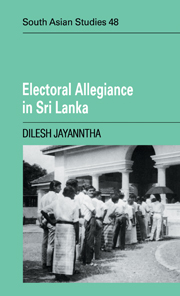Book contents
- Frontmatter
- Contents
- Acknowledgments
- List of abbreviations
- 1 Introduction
- 2 Bluville: the constituency and the patronage network of Doctor Ay (1947–1959)
- 3 Bluville: the patronage network of Korale-Mudaliyar Kit Foo and his son, Dee (1947–1959)
- 4 Bluville: the growth of the State (1956–1982)
- 5 Greenville: the patronage networks of the Mou/Nous and the Pou/Kous (1947–1959)
- 6 Greenville: the growth of the State (1956–1982)
- 7 Red Town: the urban setting (1947–1959)
- 8 Red Town: the growth of the State (1956–1982)
- 9 Communal minorities, political dissidents and the JVP
- 10 Conclusion
- Glossary of Sinhalese Terms
- References
- Index
- CAMBRIDGE SOUTH ASIAN STUDIES
2 - Bluville: the constituency and the patronage network of Doctor Ay (1947–1959)
Published online by Cambridge University Press: 11 September 2009
- Frontmatter
- Contents
- Acknowledgments
- List of abbreviations
- 1 Introduction
- 2 Bluville: the constituency and the patronage network of Doctor Ay (1947–1959)
- 3 Bluville: the patronage network of Korale-Mudaliyar Kit Foo and his son, Dee (1947–1959)
- 4 Bluville: the growth of the State (1956–1982)
- 5 Greenville: the patronage networks of the Mou/Nous and the Pou/Kous (1947–1959)
- 6 Greenville: the growth of the State (1956–1982)
- 7 Red Town: the urban setting (1947–1959)
- 8 Red Town: the growth of the State (1956–1982)
- 9 Communal minorities, political dissidents and the JVP
- 10 Conclusion
- Glossary of Sinhalese Terms
- References
- Index
- CAMBRIDGE SOUTH ASIAN STUDIES
Summary
Introduction
Bluville is a coastal electorate. In 1946 the boundaries of this constituency stretched fourteen miles along the coast and about five miles into the interior at its northernmost point. It comprised parts of Grey Pattuwa and Purville Korale. In 1959 the constituency was redrawn to exclude Grey Pattuwa and to include a larger part of Purville Korale. The southern coastal boundary was limited to only ten miles. The new northern boundary lay about eight miles into the interior.
These changes are unlikely to have significantly altered the caste composition of the electorate. There may have been a slightly larger proportion of the economically dominant Karave (fishing) caste in 1959 (25 per cent) than in 1946 (20 per cent), but the proportion of the Goigama is likely to have remained about the same at 50–60 per cent. So the Goigama community's numerical dominance in this electorate has been maintained since Independence.
The Bluville electorate of 1946 consisted of parts of two Revenue Divisions: Grey Pattuwa, which accounted for just over half of the constituency's population and Purville Korale, which contained the remainder. Each Revenue Division had, until 1938–46, been administered by a Mudaliyar. These Mudaliyars had been the most senior native officers serving in the British Provincial Administration. Their positions had often enabled them to build up considerable patronage networks in their areas of jurisdiction. These networks significantly influenced patterns of political allegiance in 1947 and after and will be examined in detail later.
The main economic activities of the people of Bluville electorate in 1947 were fishing and agriculture.
- Type
- Chapter
- Information
- Electoral Allegiance in Sri Lanka , pp. 10 - 33Publisher: Cambridge University PressPrint publication year: 1992



